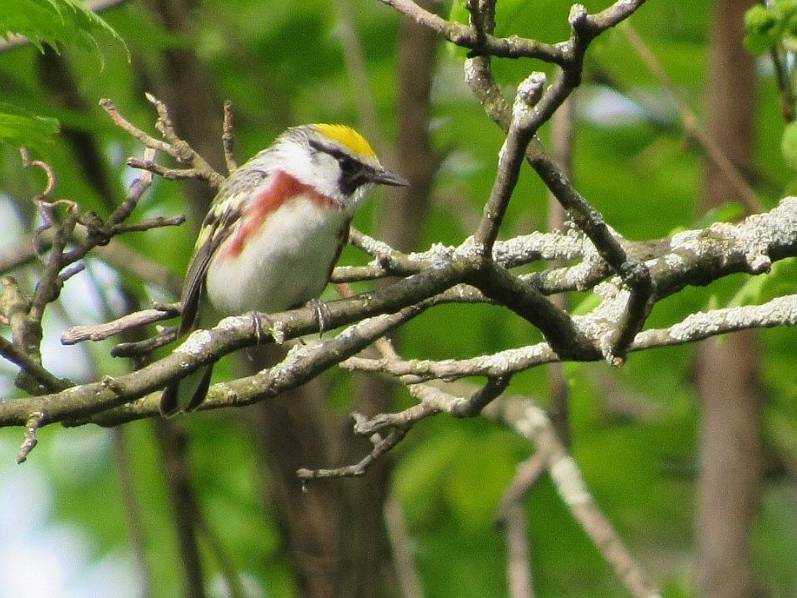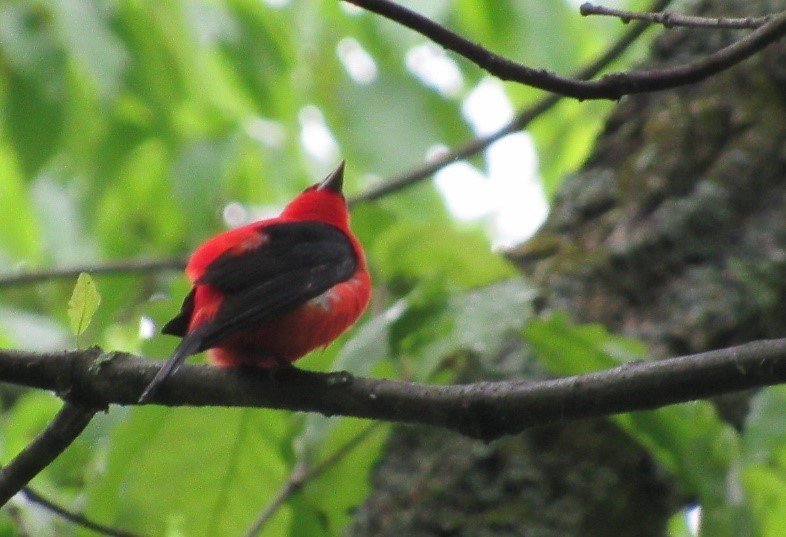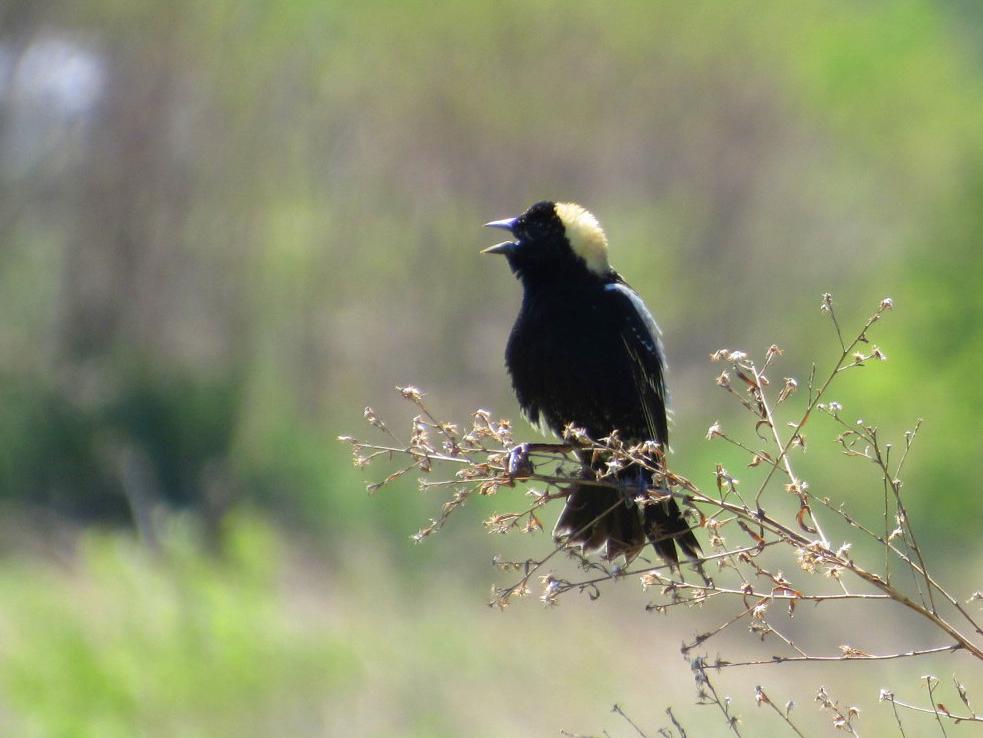For me, nothing lifts the spirits quite like the Finger Lakes Land Trust Spring Bird Quest (SBQ). I mean, who wouldn’t feel lucky and energized about getting out in our woods and fields and wetlands, just when the weather is warming up and all of our breeding birds are singing?
But in the days leading up to Memorial Day weekend and this year’s SBQ, I have to admit, it was a little challenging to look on the bright side. The weather forecast called for a very hot Saturday at the High Vista Preserve and the Hinchcliff Family Preserve, followed by big thunderstorms just at the time of our Sunday walk at the Houghton Land Preserve, then more rain and lightning on Monday at the Lindsay-Parsons Biodiversity Preserve. In the worst case, I thought, we’d get drenched, or even have to cancel a walk on the spot for the first time ever in 12 years. In the best case, I expected the birding to be difficult, and maybe for attendance to lag as people found better things to do than endure the uncooperative elements.
As it turned out, the weather was essentially perfect on Saturday and Monday, with very good human turnout as usual. Sunday’s walk did have slightly lower attendance than expected, but we had only light precipitation, which was barely perceptible as we walked through the mature broadleaf forest. By the time the clouds opened up and unfurled sheets of rain, we were already in our cars and halfway home. I felt like a gambler leaving the saloon with pockets full of silver dollars and galloping away just before the black-hatted villain steals his money and his horse.
The birding itself posed some challenges. At High Vista, we repeatedly heard Mourning Warblers, Hooded Warblers, a late Black-throated Green Warbler, and many others singing quite close by, but failed to see them in the dense vegetation. Similarly at Hinchcliff and Houghton, we saw an unexpectedly small fraction of the bird species we heard. It felt a little as if my optimism was backfiring a bit, yielding frustrated hopes instead of expected rewards, plus a nagging feeling of letting participants down.
But I talked some sense into myself. “Mark. Dude. Are you actually complaining about ‘only hearing’ birds in these beautiful places, including two new 200-acre preserves that the Land Trust has opened to the public just in the last three years [Hinchcliff and Houghton]? That is a pretty good problem to have. Do the other birders look disappointed? No. Stop feeling sorry for yourself, and just keep birding.”
So I did. And in the end, the rewards piled up beyond what even the brightest-eyed optimist would expect –including Chestnut-sided Warblers close by in perfect light at High Vista, a Brown Thrasher right by the parking lot at Hinchcliff, a pair of Scarlet Tanagers and two singing Blackburnian Warblers at Houghton, and then too many great birds at Lindsay-Parsons to fully enumerate here, including a singing Prairie Warbler and Bobolink perched for scope views for many minutes atop short nearby trees.
I ended up with a modest 65 species for the weekend, not counting a Wild Turkey whose feathers we found on the trail at the High Vista Preserve, nor a Ruby-throated Hummingbird and at least one Yellow-billed Cuckoo that others found but I missed at Lindsay-Parsons. I know I could have found a lot more species with more effort. But I’ll gladly take what we got – benevolence from the weather gods, endless energy and generous donations for the Land Trust from our attendees and other supporters, and eventual birds aplenty.
Many thanks to all for a fine weekend!
Highlights from the Preserves
High Vista Preserve
Village of Scott
Saturday, May 26
7:30-9:20 AM
Our first group – comprising birders from Ithaca, Aurora, Auburn, Skaneateles, and even all the way from California – converged on Saturday at 7:30 AM at the High Vista Preserve. We found an excellent variety of songbirds right by the parking area, including a singing Mourning Warbler, at least four Chestnut-sided Warblers, Black-throated Green Warbler, Common Yellowthroat, American Redstart, a pair of Yellow-throated Vireos, two Indigo Buntings, a Scarlet Tanager, a couple of male Baltimore Orioles, and an Eastern Wood-Pewee. The Chestnut-sided Warblers were about as cooperative and conspicuous as I’ve ever seen, and I think most or all of us saw the orioles and the wood-pewee. But alas, the other birds stayed mostly hidden, yielding views to only subsets of us, or to none of us at all.
In the woods, which have some of the densest understory I’ve recently seen in a local forest, we heard two more singing Mourning Warblers, plus several Hooded Warblers on territory, some Ovenbirds, maybe half a dozen Veeries, a Wood Thrush, a Rose-breasted Grosbeak, and others. Again, however, we didn’t manage to see any of these birds. Still, I think we got a sense of the serenity and lush vitality of those woods.
Hinchcliff Family Preserve
Village of Spafford
Saturday, May 26
9:30-11:40 AM
At 9:30, a spirited majority from the 7:30 walk rejoined me, plus a few new arrivals, at the Hinchcliff Family Preserve just five minutes north along Covey Road. Immediately upon arrival, several of us got views of a Brown Thrasher that flew from the edge of the parking area back the hedgerow along the entry road. Then we proceeded slowly around the preserve. We took our time enjoying common birds such as Common Yellowthroat, Red-winged Blackbird, Song Sparrow, and American Goldfinch, and again got a couple of nice views of Chestnut-sided Warbler. In the shady woods, cooled by breezes sweeping up from the lake, we found more of the same forest birds as at High Vista, including 3+ Hooded Warblers, Scarlet Tanager, Wood Thrush, Veery, Rose-breasted Grosbeak, and American Redstarts in the sunny patches.
We ended the morning with a slow walk back up the slope at the southern edge of the big grassy field. Here we heard Blue-winged Warbler, Eastern Towhee, and a very close but still stubbornly invisible Chestnut-sided Warbler singing its smooth, unemphatic alternate song. Finally, to cap off our morning of vociferous but visually secretive birds, we got very close to another loudly singing Mourning Warbler in some dense edge habitat not far from the parking area. This time, a couple of us at least (not I) got a long look at the bird deep in a tangle of twigs and leaves.
Houghton Land Preserve
Town of Corning
Sunday, May 27
8:00-9:55 AM
Comprising 194 acres of woods and a vast grassy field barely two miles from Corning City Hall, the Houghton Land Preserve is the Land Trust’s newest preserve, donated to the Land Trust in 2016 by Jamie and Maisie Houghton and then opened to the public in October 2017.
For most of the week leading up to the SBQ, the weather forecast was calling for big thunderstorms just at the time of our planned group walk here on Sunday. But as it turned out, the rains held off long enough for five optimistic birders (including three of us from Ithaca and two all the way from Canadice) to enjoy a slow walk all around the preserve – and to enjoy some fine birds.
Our first highlight was a pair of Scarlet Tanagers, which followed each other closely through an apparent nesting territory right next to the trail. We found a few more tanagers throughout the morning (including a male who gave us very good views out on an open branch, though my photo didn’t turn out so great), along with many Ovenbirds, Red-eyed Vireos, and Eastern Wood-Pewees, plus a couple of Veeries, a Wood Thrush, and a Great Crested Flycatcher. Together these birds provided a tidy illustration of an ecological guild of birds of mature eastern deciduous forests. We also found a Hairy Woodpecker entering a nest hole with food, while another called nearby.
The other highlight of the morning shouldn’t have been a surprise, because I found it here just a few days earlier on a scouting visit. But again the two-part song confused me until we spotted the bird high above. It was a male Blackburnian Warbler, the first of two we found. We could hear this bird singing even from 80 yards up the trail, from the corner of the big grassy field. Here we could also hear a lone Bobolink singing. I think that this had to be the first time I had ever simultaneously found territorial males of these two species.
When I first found them when scouting, I thought that the Blackburnian Warblers must be passage migrants stopping over only for a day or two en route to Canada. But now I believe that the Blackburnians are here to stay and hopefully breed during the summer. What a blessing for the residents of Corning to have this species nesting within just a few miles from the heart of downtown!
Lindsay-Parsons Biodiversity Preserve
Village of West Danby
Monday, May 28
8:00-11:40 AM
Then on Memorial Day, thirteen birders joined me for the year’s final SBQ walk, this time at the Lindsay-Parsons Biodiversity Preserve in West Danby. It took a lot of walking and waiting and watching, but in the end, our work paid off with richly rewarding views of many charismatic birds.
At first seeing birds was a little challenging, as on previous days, as some loud singers (including another Chestnut-sided Warbler issuing its smooth alternate song) gave only very fleeting views in the first grove. A singing Mourning Warbler predictably gave us no views at all. But our viewing luck turned around as we reached the island of trees at the bottom of the expansive grassy slope. Here, an impressive lineup of birds gave us fine scope views – first, a male Indigo Bunting, then a Song Sparrow, then a Prairie Warbler, and then a male Scarlet Tanager. We also saw a pair of Eastern Towhees together in the island of brush and trees at the bottom of the first open field. The female carried a very fat green caterpillar to an unseen nest. Then, around on the other side of this patch of trees and brush, many of us had a nice look at a Black-and-white Warbler in a small tree.
The scope views continued over at Coleman Lake, where we saw at least nine male Wood Ducks and a female Belted Kingfisher, plus the weekend’s only Hooded Mergansers, Mallards, and Canada Geese.
We then proceeded toward the ponds in the northern portion of the preserve. Here we had still more encounters with very cooperative birds, including another male Indigo Bunting, male and female Baltimore Orioles, an Eastern Kingbird, and a female Brown-headed Cowbird at eye level. Most intriguing here was a Yellow-billed Cuckoo that several of our group members saw, noting rufous wings and big white tail spots. Meanwhile, as we tried unsuccessfully to respot this bird, we heard another cuckoo behind us. At the time I said that it was probably another Yellow-billed Cuckoo, but upon listening to some recordings, I now think that this latter bird was a Black-billed Cuckoo (sounding mellow and gull-like, not at all wooden and hollow).
We saw relatively few birds as we continued through the final open field. The highlight here was a pair of Brown Thrashers, which regrettably gave good views only to the first in our line of walkers. But many of those in the back got the day’s best views of Chestnut-sided Warbler as a nice consolation prize.
As we headed back through the rising late-morning heat, the birding was starting to seem a little slow (though a few of us did have the morning’s only view of an Alder Flycatcher). But then atop the grassy slope where we started, we had three glorious capstones for our day, all perched up on the lone conifers – first another male Indigo Bunting, then an extremely cooperative singing Prairie Warbler, and finally a singing Bobolink. The latter two species gave long, dazzling, frame-filling scope views for everyone.
To close out the morning, I got several takers for a quick visit to the pond over on Sylvan Drive just north of the parking area. This pond, also part of the preserve, hosts an active Great Blue Heron colony with six or more giant stick nests, at least four of which had half-grown chicks. As we watched, we heard a guttural vocalization, somehow with both a cackling and mumbling quality at once, which we conjectured that the chicks themselves were making. I later confirmed this by listening to recordings from the Macaulay Library at the Cornell Lab of Ornithology.




